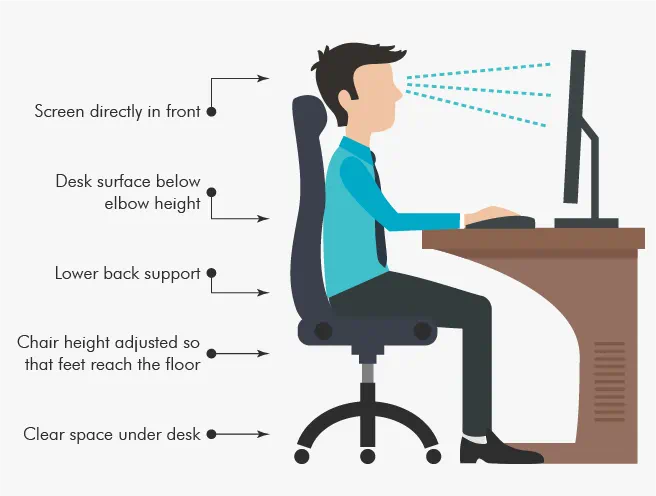
How to Choose the Right Chair and Desk to Protect Your Back from Pain: A Practical Guide
Introduction
With long hours spent at the computer, back pain and lower‑back discomfort have become common among office workers and students alike. But prevention is easier than treatment: selecting an appropriate chair and an ergonomic desk can greatly reduce spinal strain and protect your back from pain. In this guide, we present clear steps to help you choose the best office furniture, along with tips for arranging a healthy workspace that supports your back’s well‑being.
1. Why Is the “Right Chair” and “Right Desk” Crucial for Back Health?
Load Distribution: A well‑designed chair supports the spine’s natural curve and reduces pressure on the lumbar vertebrae.
Muscular Relaxation: Proper sitting posture keeps neck and shoulder muscles relaxed.
Improved Circulation: A seat with correct height and depth prevents pressure behind the knees and enhances blood flow to the legs.
Increased Productivity: Ergonomic furniture reduces fatigue and boosts focus and performance.
SEO Tip: Including “chair for back support” and “ergonomic desk” in your headings and paragraphs improves search visibility.
2. Ideal Chair Specifications for Spinal Health
Lumbar Support
Adjustable lumbar pad that fits the curve of your lower back.
Adjustability
Seat Height: Allows your feet to rest flat on the floor with knees bent at 90°.
Seat Depth: Supports thighs without pressing into the back of the knees.
Recline Angle: A back‑tilt option (around 100–110°) for periodic relaxation.
Armrests
Height‑ and width‑adjustable to support shoulders and forearms, keeping elbows at 90°.
Seat & Back Padding
Medium‑firm cushioning that distributes weight and minimizes pressure points.
Stable Base & Casters
A sturdy five‑point base with smooth‑rolling wheels to move effortlessly without straining.
3. Choosing the Right Desk (Ergonomic Desk)
Desk Height
Approximately 70–75 cm for most people, so elbows rest comfortably at desk level while typing.
Adequate Surface Area
Space to position keyboard and mouse so your forearm remains straight, not bent.
Adjustable Sit–Stand Option (Optional)
Enables alternating between sitting and standing to relieve spinal pressure.
Clutter‑Free Surface
A tidy desktop helps you arrange work tools ergonomically.
Monitor Placement
Top of screen at or just below eye level (10–20° below horizontal), 50–70 cm away.
SEO Tip: Including “ergonomic desk” and “proper desk setup” in subheadings strengthens your article’s SEO.
4. Steps to Arrange an Ideal Workspace
Adjust Chair Height & Position
Raise the chair so your feet rest flat on the floor and your elbows align with the desktop.
Position Screen & Keyboard
Place the keyboard directly in front of you, with the mouse beside it.
Face the monitor squarely—avoid twisting your neck.
Use Wrist & Arm Support
Consider elbow pads or wrist rests for additional support when needed.
Optimize Lighting
Side or overhead lighting to minimize eye and neck strain.
Schedule Regular Breaks
Stand and move for 1–2 minutes every 30–45 minutes.
Perform light neck, shoulder, and back stretches.
5. Quick Stretching Exercises at Your Desk
Gentle Head Turns
Slowly rotate your neck five times in each direction.
Shoulder Shrugs
Lift shoulders toward ears, then lower slowly—10 repetitions.
Lateral Trunk Stretch
Lean your torso gently to each side, holding for 15 seconds.
Upper‑Back Stretch
Extend arms forward, press palms together, and round shoulders to feel a stretch between shoulder blades.
6. Role of Ziatozone Gel in Supporting Back Health
After a long day of sitting or standing, you may feel stiffness or tension in your back muscles. Ziatozone Gel (ozone gel) can help by:
Relieving Muscle Tension: Menthol’s cooling and mild warming effect soothes tight muscles.
Stimulating Local Circulation: Ozone‑oxidized oil enhances tissue oxygenation.
Promoting Recovery: Amino acids and devil’s claw extract accelerate tissue repair.
How to Use: Clean and dry the area, apply a thin layer of gel, massage gently for 2–3 minutes, and repeat twice daily or as needed.
Conclusion
Selecting a chair designed for back support and an ergonomic desk forms the foundation of preventing back pain and daily fatigue. Alongside proper posture and regular stretching, incorporating Ziatozone Gel into your evening routine further aids recovery and relaxation. Follow these simple guidelines to create a healthy, pain‑free workspace and boost your productivity without sacrificing comfort.